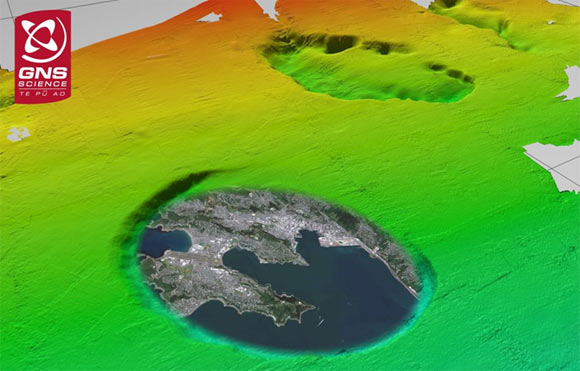Giant Craters on the Seabed
off the coast of New Zealand
In 2013, marine geophysicist Dr Bryan Davy from GNS Science found what may be the world’s largest gas eruption craters on the seafloor about 310 miles east of Christchurch, New Zealand.
(Giant craters off Christchurch New Zealand are thought to have formed due to large gas eruptions during previous episodes of sea bed warming. Could human warming set be setting off something similar for the Arctic? Image source: Mysterious Giant Crater Like Structure Found Near New Zealand.)
The
craters, which the researchers called ‘pockmarks,’ formed in an
active gas zone along the ocean bottom. They measured from 250 meters
to 7 miles in diameter and about 300 feet deep. With the largest
crater able to encompass all of lower Manhattan.
The
craters are thought to have formed during ice ages when sea levels
lowered off New Zealand causing the sea bed to warm and gas hydrate
to thaw. Eventually, the gas is thought to have erupted into the
surrounding water with a portion bubbling up into the atmosphere.
GEOMAR
seismic records indicated active gas pockets beneath the crater
zones. Dr Joerg Bialas, a GEOMAR scientist noted:
Gas
release from the larger pockmarks may have been sudden and possibly
even violent, with a massive volume being expelled into the ocean and
atmosphere within hours or days.
The
300 foot depth of the craters touched the hydrate stability zone even
as their large size indicated that massive pockets of the gas lifted
away large sections of sea bed suddenly and violently. It’s the
kind of rapid destabilized gas release that may well represent a
worst-case Arctic warming scenario.
Cause
for Appropriate Concern
So
the question must be asked — is the Yamal crater physical
validation of a catastrophic methane hydrate release mechanism that
has circulated, as theory, through the geophysical sciences for
decades? One that involves large eruptions that displace massive
sections of earth and seabed during a violent release process. Are
the Siberian methane blowholes smaller examples of what can happen on
a much greater scale? And does the methane overburden in the Arctic,
the documented increasing Thermokarst Lake release, the sea bed
methane release in the Laptev and ESAS, and the new formation of
methane blow holes in Yamal in the context of a rapidly warming
Arctic tundra and sea bed (seeing unprecedented rates of warming)
represent a growing risk for this kind of release?
Under
even a ‘moderate’ 1 to 3.5 gigaton Arctic carbon release rate by
end century given by the survey of 100 Arctic scientists, there will
likely be more than enough potential freed methane to include large
scale catastrophic releases similar to the kind seen off New Zealand
and elsewhere (250 meter to 7 mile wide cratering events).
In
this context, the issue is not one of ‘apocalypse now’ or
‘apocalypse not.’ That framing is all wrong. This issue is one of
how much or how little geophysical upheaval and related methane
release we will see — and how soon. One of how rapidly humans can
stop making the situation even worse, by drawing down their own
catastrophic emission rates as rapidly as possible.
There
is, therefore, more than enough cause for appropriate concern and
continued monitoring of what appears to be an ongoing destabilization
of Arctic carbon stores — large enough to represent a variety of
hazards both terrestrial and atmospheric.




Why don't we deep sea drill and see what happens? sigh. I sent a Robbertscribbler link like this off to Prime Minister John Key. He said thanks,
ReplyDeleteWhat he probably meant was "thanks. I'm not bothered"
Delete.....at the end of the day
Delete